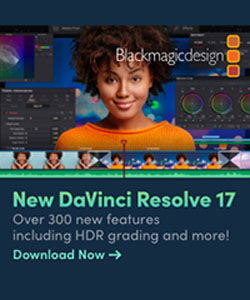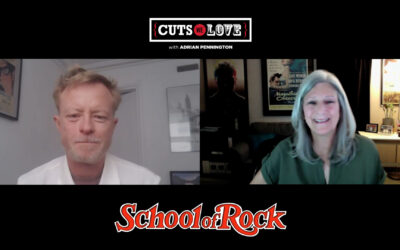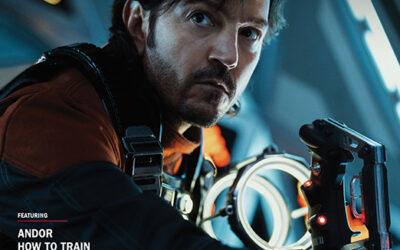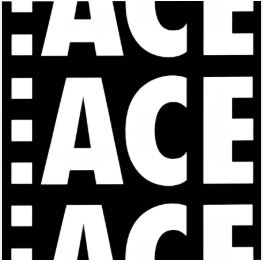
 1st Qtr, 2020
1st Qtr, 2020
Alan Heim, ACE, should need no introduction – but here goes. The former President of American Cinema Editors and current President of the Motion Picture Editors Guild, Heim is heralded as much for supporting the craft of the cutting room as for his estimable body of work in shaping art on screen. He has edited for some of the best directors to ever grace the business, including Sidney Lumet, Mel Brooks, Bob Fosse, John Hughes and Milos Forman. An Academy Award® winner for editing for Fosse’s All That Jazz and Oscar® nominated for Lumet’s Network, he has also won or was nominated for several ACE Eddies and Emmys®. “Working in film, you manipulate time,” Heim says. “The editing process is really the last opportunity to change the story before it goes out into the world.”
NEW YORK BEGINNINGS
Brought up in The Bronx, a block from the 41st Precinct (later better known as “Fort Apache”), Heim’s first paying job (aged 13) was as the projectionist for the Police Athletic League in the basement of the police station, a result of being on the audiovisual squad at school since the age of 10.
 “There were at least five movie theaters within walking distance of my home and I spent many Saturday matinees in them,” Heim recalls. “As a child I imagined that films somehow appeared in the theaters as if by magic, made in some Hollywood wonderland far beyond my reach. None of my career was on my radar then.”
“There were at least five movie theaters within walking distance of my home and I spent many Saturday matinees in them,” Heim recalls. “As a child I imagined that films somehow appeared in the theaters as if by magic, made in some Hollywood wonderland far beyond my reach. None of my career was on my radar then.”
An avid photographer in his early teens, Heim harbored a “vague fantasy” of a future in photography but it was only when he dropped out of CCNY in his first year that he discovered the college’s Film Institute. “At the time this was chaired by a great documentarian named George Stoney (All My Babies). There were so few students in the late ‘50s that I took many of my courses at night, including editing. I discovered that I had a talent for looking at our meager material with a different eye than most in my class, and when George viewed my first student film (three minutes long, one roll of film) he asked me to edit it, though it was intended to be cut in the camera. That got me really hooked.”While he struggled to gain work after graduation in 1959, he was able to pursue his new interest courtesy of the U.S. Army as part of the military draft. “I never thought that I would actually serve. I was wrong but it turned into a great piece of luck. A person I worked with as a sound assistant introduced me to the Major heading up the film division of the Army Pictorial Center in Queens and he agreed to try and get me stationed there after basic training. Unbelievably, he was able to do it. I spent 18 months there where a civil servant taught me how to really edit music.”
 After being released from the military, Heim’s career began to gather pace. He gained a union card as a result of assisting at a commercials house, before composer and music editor Robert Stringer invited him to work on TV series The Nurses, as a music and sound effects editor. He got his break into features as sound effects editor on The Pawnbroker edited by Ralph Rosenblum, who became a mentor. The 1964 drama was the first major American film that tackled the horrors of the Holocaust and controversially (given its subject matter) was the first film featuring bare breasts to receive Production Code approval. It was also Heim’s first encounter with director Sidney Lumet who a few years later who would trust the budding editor with his first solo picture credit.
After being released from the military, Heim’s career began to gather pace. He gained a union card as a result of assisting at a commercials house, before composer and music editor Robert Stringer invited him to work on TV series The Nurses, as a music and sound effects editor. He got his break into features as sound effects editor on The Pawnbroker edited by Ralph Rosenblum, who became a mentor. The 1964 drama was the first major American film that tackled the horrors of the Holocaust and controversially (given its subject matter) was the first film featuring bare breasts to receive Production Code approval. It was also Heim’s first encounter with director Sidney Lumet who a few years later who would trust the budding editor with his first solo picture credit.
In the interim, Heim acted as associate editor on the documentary Festival which had been filming the Newport folk music scene between 1963 and 1966. At the same time, Heim took on a sound and music role (credited sound effects) on The Eleanor Roosevelt Story. Both films went on to win Academy Awards for best documentary (in 1967 and 1965 respectively) but had cemented in Heim a desire to move into picture editing. “I decided to give up sound editing and work as a picture assistant to learn the ropes in the cutting room,” Heim says. “Sidney came to my rescue.”
Heim was sound editing to the picture cutting of Gerald Greenberg, ACE, on Lumet’s comedy Bye Bye Braverman in 1968 when he was offered the chance to edit The Sea Gull. The drama, based on Anton Chekhov’s play and featuring James Mason and Vanessa Redgrave, received mixed reviews but encouraged the director to invite Heim back to cut Last of the Mobile Hot Shots, adapted by Gore Vidal from a Tennessee Williams play and shot by James Wong Howe. “I went to the rehearsals and was dazzled by the company.
 As on Sea Gull, Sidney stood behind me and had a hand in every cut. I was learning from him but began to feel underused and uncomfortable. When I finished the picture, after several lowkey disagreements with Sidney, I left it in the more-than-capable hands of my brilliant assistant, Craig McKay (now ACE).” Far from jumping ship, Heim was in demand, this time from filmmaker and iconoclast Mel Brooks who wanted him to edit The Twelve Chairs on location in the former Yugoslavia. It wasn’t their first encounter.
As on Sea Gull, Sidney stood behind me and had a hand in every cut. I was learning from him but began to feel underused and uncomfortable. When I finished the picture, after several lowkey disagreements with Sidney, I left it in the more-than-capable hands of my brilliant assistant, Craig McKay (now ACE).” Far from jumping ship, Heim was in demand, this time from filmmaker and iconoclast Mel Brooks who wanted him to edit The Twelve Chairs on location in the former Yugoslavia. It wasn’t their first encounter.
Before Sea Gull Rosenblum had hired Heim for the sound editing on Brooks’ Nazi satire The Producers, taking over the final editing of the picture when Rosenblum had to leave the project “in part because of their mutual dislike,” Heim confides. “There were only the titles to supervise and one scene which Mel had been unhappy with – signing the contract in the Nazi’s apartment,” Heim relates. “It had a lot of funny dialogue but it was presented as a single master shot, something I felt needed different coverage and a different pace. I convinced Mel to give me two days to recut it. I found close-ups and new angles, restructured it and when I showed it to Mel he accepted it on the spot.” At the cast-and-crew screening Heim recalls the audience laughing so hard that the dialogue was almost obliterated –
 “I loved feeling the crowd laugh and wanted to become a picture editor more than ever.” Next up, after Sea Gull, was Doc, a 1971 Western loosely based on Gunfight at the O.K. Corral and starring Stacy Keach and Faye Dunaway, directed by Frank Perry. It’s the only film Heim has cut in scene order. “There had been a lot of jealousies on the film set in Spain, which I discovered when I cut a simple scene of Stacy Keach and Harris Yulin playing cards which just didn’t seem to match.
“I loved feeling the crowd laugh and wanted to become a picture editor more than ever.” Next up, after Sea Gull, was Doc, a 1971 Western loosely based on Gunfight at the O.K. Corral and starring Stacy Keach and Faye Dunaway, directed by Frank Perry. It’s the only film Heim has cut in scene order. “There had been a lot of jealousies on the film set in Spain, which I discovered when I cut a simple scene of Stacy Keach and Harris Yulin playing cards which just didn’t seem to match.
When revisiting the whole scene I found that the actors had been changing vests between takes. When I asked Harris why, he told me that they were tormenting the script supervisor. Then he asked, “Did you catch the shirts?” And it turns out they were also changing shirts with subtly different striped patterns between takes and I missed it because on a Moviola screen, that’s really hard to see.” He adds wryly, “It can sometimes be very tough to be an editor.”
Then came the career- and life-changing moment when he met Bob Fosse. “I discovered in Fosse a really kindred spirit. The whole freedom of editing that I got from Bob fits into my whole psyche.” Fosse was as innovative a choreographer as he was a filmmaker. His sophomore directorial effort Cabaret in 1972 won eight Oscars and beat Francis Ford Coppola to Best Director for The Godfather.
Heim, by his own account, was not a musician and at that time wasn’t a fan of musicals either but a chemistry between them led to a stunning and lifelong artistic collaboration. “I first met Bob at the rehearsal studio for Liza with a Z (the same venue that appears in All That Jazz) and I was dazzled by the energy in the room. Just the thrill of being surrounded by the dancers there was astounding. They would come sliding right up to our feet, and the room was filled with heat and sweat – movement and color. I knew how to make material work with music and to make music work with material but Bob was really disappointed that I wasn’t actually a musician and couldn’t read music.
Later that night I saw Cabaret and I knew then that I really wanted to work with him. Luckily, it worked out.” Their first venture together was a one-hour live concert of Liza with a Z filmed with nine 16mm cameras. “A tremendously complex film. The main camera broke in the middle of the first act, so we had no master shots and it was lit theatrically, which led to certain problems because it didn’t translate well to television. We started fiddling around with the film to cover all that and sort of never stopped fiddling.” The fiddling worked since it landed Fosse an Emmy and Heim his first Emmy nomination.
The film they made next redefined the Hollywood biopic. Lenny, about comic Lenny Bruce, was based on a play and “terrific” script by Julian Barry featuring Dustin Hoffman in the title role but the storytelling began to change radically in the edit. “We were trying to get across the complexity of Lenny’s personality and it wasn’t working so we began to intercut scenes of his stand-up routines with moments in his life. This idea existed in the script but we just went a lot further. Actors like to be liked and Dustin wanted to make Lenny nice but it didn’t work for the sharp-edged guy that [he] actually was. “We found that the shorter the comedy routines got, the more juxtapositions about Lenny’s life we made, the faster it got and the edgier Dustin’s performance became.”
Lenny received six Oscar nominations including for Hoffman and Best Picture. Heim and Fosse took the techniques they’d developed in the cutting room into their next film, All That Jazz, a semi-autobiographical account of Fosse’s life and career. “Jazz is about show business but it’s much more about the baring of an individual’s soul. It’s done in a kind of brutal manner. Some critics talked about the egotism involved but he’s taking himself apart. In fact, Roy Scheider is playing a character who happens to be Bob. In the cutting room I had to unlearn saying ‘you’ when talking about the character. I had to say ‘Joe’ or ‘him.’ I knew it was his life of course having lived part of it.”
It paid off handsomely as the picture, an instant classic, gained nine Academy Awards nods with Heim receiving the Oscar, a BAFTA® and ACE Eddie for his work. The pair went on to make Star 80 (1983), about Playboy model Dorothy Stratten, who was murdered by her husband Paul Snider, before Fosse’s life was tragically cut short by a heart attack in 1987, aged 60. “He was a genius. He made so few movies that I feel incredibly fortunate to have known him and to have worked with his material. He would come into the cutting room and we would rework scenes, to polish them as much as possible, to get the most out of it.”
Fosse referred to Heim as his collaborator, which Heim accepts as a great compliment.“We worked hard, but what was so nice about working with him was that he always acknowledged it. Every day was an adventure, absolutely every day.” As befits a filmmaking collaboration that advanced the concept of manipulating time on screen, we have skipped ahead in our narrative of Heim’s career.
All That Jazz was not his first or only brush with Oscar. In 1976, Heim had renewed his association with Lumet for the broadcast news drama Network. It’s a film which has lost none of its coruscating cultural impact. “The idea of a TV personality taking over the attention of America? It’s remarkable.”
This time around, Lumet left his editor alone. “I knew I could do it on my own. Paddy Chayefsky was a brilliant, prescient polemicist and a poet who wrote a near flawless script. It was beautifully acted and directed perfectly by Sidney. What more could an editor want? We turned the film over in just five days and it took 10 weeks from production to print.”
Actor Peter Finch’s standout performance was Oscar awarded posthumously. “Performances are the raw material,” Heim says. “I look for the best takes and try very hard to protect the actor’s integrity.” “People still send me notes about Network and All That Jazz. It’s nice to have worked on something that’s not ephemeral.
I always feel nowadays that films have the shelf life of a cantaloupe. As soon as they enter theaters they go rotten.” Among many other projects, Heim worked as a music editor on Paul Newman’s Rachel, Rachel (1968) and as picture editor including Godspell (1973); Funny Farm (1988) for George Roy Hill; She’s Having a Baby (1988) for John Hughes; Milos Forman’s Valmont (1989) and Billy Bathgate (1991) for Robert Benton. He won two additional Eddie Awards for Introducing Dorothy Dandridge and Grey Gardens, and shared an Emmy for his work on the TV miniseries Holocaust (1978). He moved to Los Angeles in 1995 where, having learned to edit on the Moviola, then the Kem and Steenbeck, he took to editing on Avid in stride.
Heim worked on Copycat and The Mirror Has Two Faces (for Barbra Streisand); American History X and The Notebook, Alpha Dog and The Other Woman for Nick Cassavetes. Unwittingly, Heim has even become part of folklore, with his work and actual persona depicted in the critically-acclaimed series Fosse/Verdon about which Heim has mixed feelings. “I knew him for 16 or so years, smoked grass with him, attended parties and never saw him as he was depicted. That said, I’m happy for Gwen’s memory to be enhanced.
Few show dancers get enough credit or even much history. Also, it was kind of fun to have somebody play me, no matter how inaccurate. I don’t believe I was quite so heavy and I know I didn’t wear glasses until after Star 80 – but that’s just vanity.”
When he wasn’t in the cutting room, Heim served as a board member of ACE for more than 25 years, which included serving four terms as president, from 2004-2008 and 2012-2016, and four terms as vice president, from 2008-2012 and 2016-2019.
As part of his tireless advocacy for the work of editors everywhere he was instrumental in producing The Cutting Edge: The Magic of Movie Editing. The feature documentary recounted the history of the cutting room and extolled the virtues of its artistry with the testimonies of a who’s who of cinema talent. Quentin Tarantino, Steven Spielberg, Martin Scorsese, Jodie Foster, George Lucas, James Cameron and Sean Penn were some of the many talented artists contributing to the project thanks to the efforts of Heim and the documentary’s director Wendy Apple.
The film also captured the thoughts of master craftspeople like Walter Murch, ACE; Michael Kahn, ACE; Thelma Schoonmaker, ACE; and the late Sally Menke, ACE. “We thought we could raise the profile of the editing community,” Heim says. “It’s the editors’ shot at getting some airtime.”
Always humble, charming to a fault and generous with an anecdote, Heim is a worthy recipient of ACE’s highest honor. “I have been privileged to be a part of a fantastic community of people over many years who have advanced the art of storytelling in the editing room,” he says. “To be honored with this award from my peers in the editing community is extremely meaningful, and the recognition of my colleagues is most deeply appreciated.”
Related Content
Cuts We Love: “The Diving Bell and the Butterfly”
"School of Rock" Interview by Adrian Pennington with Juliette Welfling, editor of The Diving Bell and the ButterflyMore...Explore Your Favorite TopicsEditFestTechnologyInterviewsMoviesNews A short excerpt from the ‘Virtual Glass of Wine’ British Film Editors interview...
Cuts We Love: “School of Rock”
"School of Rock" Interview by Adrian Pennington with Sandra Adair, ACE, editor of School of RockMore...Explore Your Favorite TopicsEditFestTechnologyInterviewsMoviesNews A short excerpt from the ‘Virtual Glass of Wine’ British Film Editors interview series. David...





